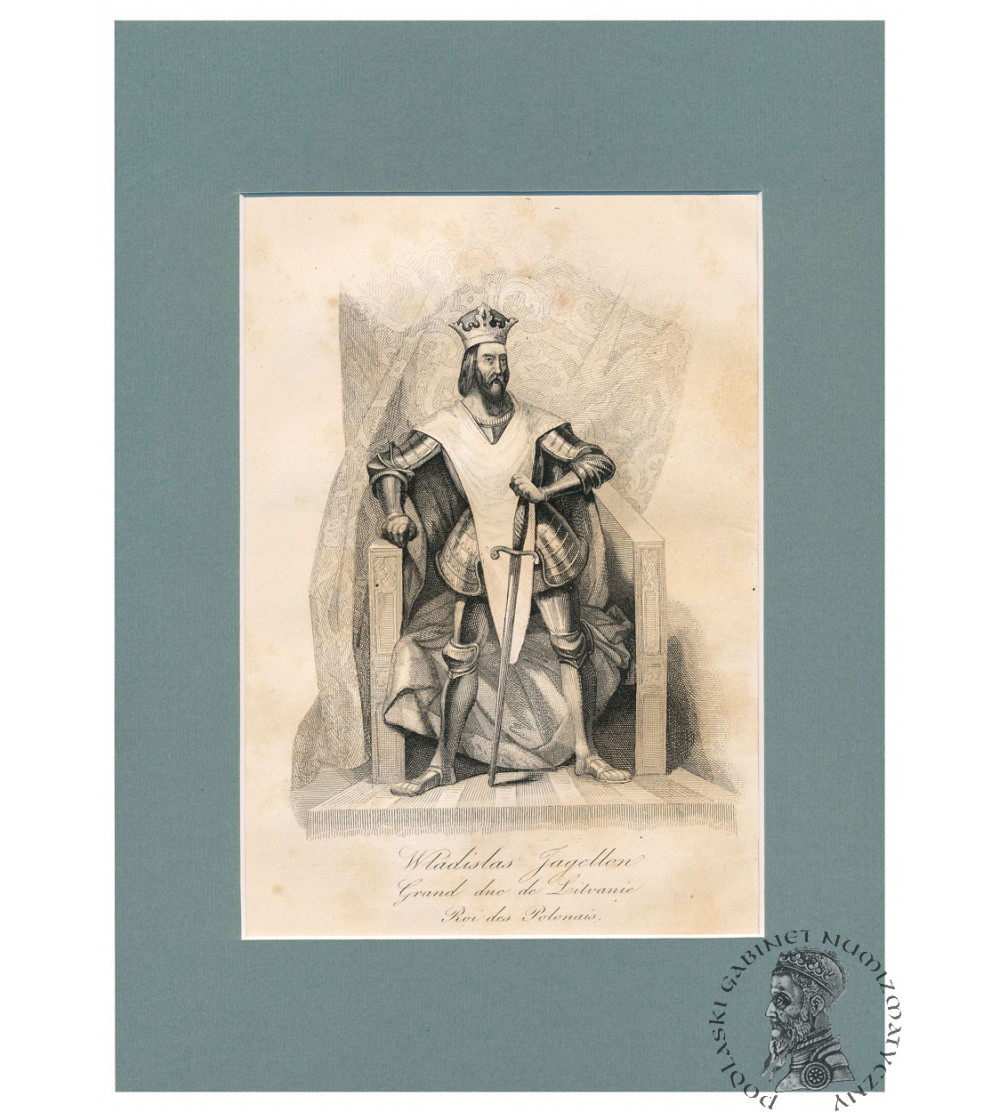




Wladyslaw Jagiello, King of Poland, Grand Duke of Lithuania, Wladislas Jagellon, portrait, steel engraving 19th century, work from Leonard Chodźko's volume - La Pologne historique, litteraire, monumentale et ilustree, Paris 1839-1841, all A4 format (passe-partout), image dimensions 14 cm x 20 cm, very good condition.
Ladislaus Jagiello (c. 1362-1434). Founder of the Jagiellonian dynasty. Ladislaus II Jagiello (born c. 1362, died June 1, 1434) - Grand Duke of Lithuania from 1377 and King of Poland from 1386. A descendant of the Lithuanian family of Gediminas and founder of its Polish branch, the Jagiellonian dynasty. Jogaila was one of more than a dozen sons and a total of more than twenty children of Grand Duke Olgierd. It used to be claimed that he was born around 1352, but in more recent scholarship this date has been pushed back by a decade. Although Jagiello had older brothers and half-brothers, he took over the throne from his father as a teenager. He had to share power with his uncle Kiejstut, and then his cousin brother Witold. He probably had the former assassinated, while with the latter he engaged in years-long battles. His mother was a Christian, and Jagiello himself showed tolerance to followers of Catholicism and Orthodoxy. In 1385 he was invited to the Polish throne and made a number of promises in Krewa related to his planned marriage to the underage Jadwiga Andegawenska. In early 1386, he arrived in Poland. On February 15 he was baptized at Wawel Cathedral, on February 18 he married Jadwiga, and on March 4 he was crowned as the new king. The treaty resulted in a personal Polish-Lithuanian union, the nature of which was clarified in 1401 (the so-called Vilnius-Radom union) and 1413 (the Horodle union). Jagiello - who took the name Wladyslaw at his baptism - led the Christianization of the last formally pagan country in Europe. His reign was marked by almost permanent conflict with the Teutonic Order, which did not recognize the union, and the conversion of Lithuania. In 1410 the king took part in the victorious Battle of Grunwald, and in 1411 he concluded the Peace of Torun with the Teutonic Knights. Subsequent wars occurred in 1414 (the "Hunger War"), 1419 (the "Reverse War"), 1422 and 1431. The king was known for his simplicity of dress, strict customs and superstitiousness. Because he ruled the country on constant travel and traveled thousands of kilometers each year, he is referred to as rex ambulans, the wandering monarch. Ladislaus Jagiello married four times, but he experienced personal happiness only in his third union. His relations with Jadwiga Andegawenska and Anna Cylejska were cool and filled with suspicion. Truly successful, but also very short-lived, was the relationship formed with the king's old friend and godsister, Elisabeth of Pilcza. Neither of these partners bore the ruler a son. The heirs to the throne - Ladislaus Varna and Casimir Jagiellon - were not born until the last years of Ladislaus Jagiello's life. Their mother was the Ruthenian princess Sophia Holshanskaya. source: wielkahistoria.pl
CHODŹKO, Leonard Borejko (1800-1871), La Pologne historique, litteraire et monumentale, (...), 1835-1842. A monumental work by the famous Polish émigré publisher Leonard Chodźko which is a history and geographic-political description of Poland. The work was published in three volumes. The first part is the history of Poland from the earliest times to the reign of Wladyslaw Lokietek. The second volume covers the history of Poland from the reign of Casimir the Great to the death of Stefan Batory, while the last volume covers the history of Poland from the beginning of the reign of Sigismund III Vasa until the events contemporary to the Author and the Readers, i.e. the November Uprising. Each part also contains descriptions of unique and interesting places in Poland, as well as basic information about literature, art and science. In addition, the work contains examples of exceptional monuments in the Polish lands. An important part of the work includes fairy tales, legends and short stories, as well as an essay on dramatic theater in Poland. The work also contains a description of Polish dances, such as the polonaise, mazurka, and krakowiak. The work is very richly illustrated, with numerous intaglios, natural monuments, sacred objects, castles, palaces, cities, portraits of important historical figures from the history of Poland, works of art, notes of songs, etc. This brings the total to 180 engravings (including maps), in a set of three volumes, i.e. 60 engravings for each volume collated with a table at the beginning of the volume.